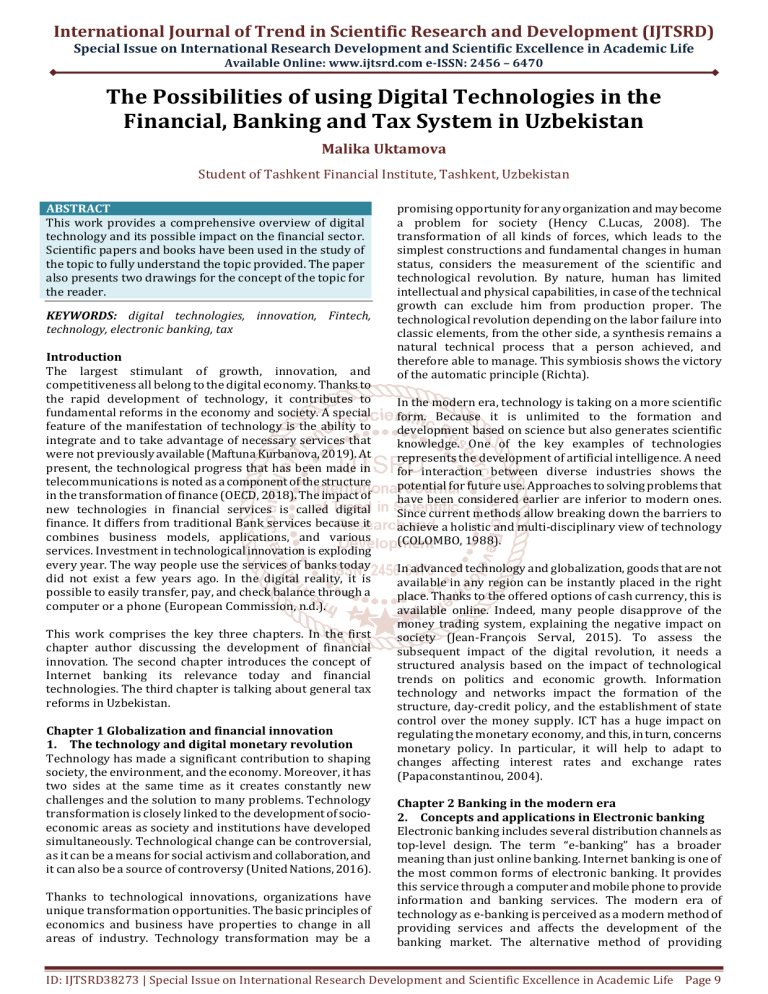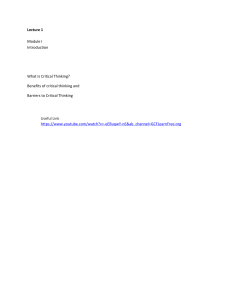
International Journal of Trend in Scientific Research and Development (IJTSRD)
Special Issue on International Research Development and Scientific Excellence in Academic Life
Available Online: www.ijtsrd.com e-ISSN: 2456 – 6470
The Possibilities of using Digital Technologies in the
Financial, Banking and Tax System in Uzbekistan
Malika Uktamova
Student of Tashkent Financial Institute, Tashkent, Uzbekistan
ABSTRACT
This work provides a comprehensive overview of digital
technology and its possible impact on the financial sector.
Scientific papers and books have been used in the study of
the topic to fully understand the topic provided. The paper
also presents two drawings for the concept of the topic for
the reader.
KEYWORDS: digital technologies, innovation, Fintech,
technology, electronic banking, tax
Introduction
The largest stimulant of growth, innovation, and
competitiveness all belong to the digital economy. Thanks to
the rapid development of technology, it contributes to
fundamental reforms in the economy and society. A special
feature of the manifestation of technology is the ability to
integrate and to take advantage of necessary services that
were not previously available (Maftuna Kurbanova, 2019). At
present, the technological progress that has been made in
telecommunications is noted as a component of the structure
in the transformation of finance (OECD, 2018). The impact of
new technologies in financial services is called digital
finance. It differs from traditional Bank services because it
combines business models, applications, and various
services. Investment in technological innovation is exploding
every year. The way people use the services of banks today
did not exist a few years ago. In the digital reality, it is
possible to easily transfer, pay, and check balance through a
computer or a phone (European Commission, n.d.).
This work comprises the key three chapters. In the first
chapter author discussing the development of financial
innovation. The second chapter introduces the concept of
Internet banking its relevance today and financial
technologies. The third chapter is talking about general tax
reforms in Uzbekistan.
Chapter 1 Globalization and financial innovation
1. The technology and digital monetary revolution
Technology has made a significant contribution to shaping
society, the environment, and the economy. Moreover, it has
two sides at the same time as it creates constantly new
challenges and the solution to many problems. Technology
transformation is closely linked to the development of socioeconomic areas as society and institutions have developed
simultaneously. Technological change can be controversial,
as it can be a means for social activism and collaboration, and
it can also be a source of controversy (United Nations, 2016).
Thanks to technological innovations, organizations have
unique transformation opportunities. The basic principles of
economics and business have properties to change in all
areas of industry. Technology transformation may be a
promising opportunity for any organization and may become
a problem for society (Hency C.Lucas, 2008). The
transformation of all kinds of forces, which leads to the
simplest constructions and fundamental changes in human
status, considers the measurement of the scientific and
technological revolution. By nature, human has limited
intellectual and physical capabilities, in case of the technical
growth can exclude him from production proper. The
technological revolution depending on the labor failure into
classic elements, from the other side, a synthesis remains a
natural technical process that a person achieved, and
therefore able to manage. This symbiosis shows the victory
of the automatic principle (Richta).
In the modern era, technology is taking on a more scientific
form. Because it is unlimited to the formation and
development based on science but also generates scientific
knowledge. One of the key examples of technologies
represents the development of artificial intelligence. A need
for interaction between diverse industries shows the
potential for future use. Approaches to solving problems that
have been considered earlier are inferior to modern ones.
Since current methods allow breaking down the barriers to
achieve a holistic and multi-disciplinary view of technology
(COLOMBO, 1988).
In advanced technology and globalization, goods that are not
available in any region can be instantly placed in the right
place. Thanks to the offered options of cash currency, this is
available online. Indeed, many people disapprove of the
money trading system, explaining the negative impact on
society (Jean-François Serval, 2015). To assess the
subsequent impact of the digital revolution, it needs a
structured analysis based on the impact of technological
trends on politics and economic growth. Information
technology and networks impact the formation of the
structure, day-credit policy, and the establishment of state
control over the money supply. ICT has a huge impact on
regulating the monetary economy, and this, in turn, concerns
monetary policy. In particular, it will help to adapt to
changes affecting interest rates and exchange rates
(Papaconstantinou, 2004).
Chapter 2 Banking in the modern era
2. Concepts and applications in Electronic banking
Electronic banking includes several distribution channels as
top-level design. The term “e-banking” has a broader
meaning than just online banking. Internet banking is one of
the most common forms of electronic banking. It provides
this service through a computer and mobile phone to provide
information and banking services. The modern era of
technology as e-banking is perceived as a modern method of
providing services and affects the development of the
banking market. The alternative method of providing
ID: IJTSRD38273 | Special Issue on International Research Development and Scientific Excellence in Academic Life Page 9
International Journal of Trend in Scientific Research and Development (IJTSRD) @ www.ijtsrd.com eISSN: 2456-6470
services online, creates challenges for traditional banks, as it
neutralizes possible advantages. But this does not mean that
traditional banks may disappear, conversely, will take on a
new level for further operation in the banking market. The
key advantages of e-banking are increasing the reputation of
the bank, efficiency, cost savings, and customer satisfaction
(Long Pham, 2015).
Meanwhile, increased investment in banking technology has
resulted in the growth of efficiency and innovation. The
increasing complexity of e-services and the widening range
have contributed to the growth of clients and their demand
for continuous technologies. An important aspect of internet
banking is the ability to expand operations and provide
optimal services at minimal operation costs. It is necessary
to consider also risks which can be connected with ebanking. Moreover, the use of e-banking has led to threats of
cyber-crime. But every bank has its security system. The
major risks of e-banking are the authenticity of the
stakeholders, the security of transactions, viruses, and the
availability of the Internet. However, customers continue to
use the services of the bank in its service branches.
Picture 1Use of online and mobile apps for different
banking activities (Val Srinivas, 2018)
Security of transactions, viruses, and the availability of the
Internet. However, customers continue to use the services of
the bank in its service branches. Taking into account that,
over the last few years Internet banking has become the
principal instrument of communication between consumers
and banks (IMOLA DRIGĂ, 2014). To identify a key business
opportunity, it is necessary to collect customer data for
depth research. It carries out with the help of web analytics,
which has the capacity of careful customer tracking in
relationship management. Since the internet is a unique way
to serve, it is very important to develop the relationship
between the client and the bank(Emanuela, 2015).
2.1.
Customer adoption and Perception towards
Fintech
The twenty-first century is considered an era of information
technology that has come to simplify daily trade
transactions. To meet the needs of clients, there are business
models that are developed with the help of financial
technologies. The term as “the new technology in the
financial services industry” is called “Fintech” (Tun-Pin
Chong, 2019). Fintech-is to be described as a process that
introduces disruptive and transformational innovations in
the financial sector. Organizations using Fintech differentiate
themselves by providing new applications to partners,
financial institutions, and direct clients. There is no doubt
that Fintech has caused a spike in the sector of financial
institutions and business operators. It is believed that
Fintech belongs to the fourth generation of the industrial
revolution as it destroys industrial structures and erases
borders. Reducing the cost of remittances, preserving the
expertise in innovation and non-banking services is Fintech’s
principal focus (Muhammad Anshari, 2020). Besides, Fintech
helped to create a fresh look for the financial market and
alternative ways of solving problems related to financial
transactions. An example is Paypal, which has become one of
the successful examples of financial technology. Paypal’s
chief objective is to execute transactions and manage money
through online trading. Another achievement is the wellknown eBay. The platform where there is a huge range of
products that can be purchased through reliable online
payments (Truong, 2016).
Chapter 3 Tax implications in banking
3. Consumption-oriented tax system
The State establishes a compulsory tax to perform economic
growth and development. The provision of economic, social,
and political development is directly related to the volume of
revenues received in the country. Thanks to the organized
system of taxation, the government obtains appropriate
profits to meet the needs of infrastructure. The tax is one of
the essential subjects in every society. Due to that, states
receive the necessary financial resources to carry out their
direct duties. The taxation structure represents an effective
method for mobilizing resources and stimulating economic
growth (Gylych Jelilov, 2016).
The introduced tax systems in the socialist's epoch command
economies were incompatible with Western standards and
also more limited. Salary, business and turnover rates were
the principal source of tax revenue. Besides, the collection of
taxes from individuals represents a minor part of all
revenues. In most cases, tax mechanisms have always been
complex because of several uncertain tariffs and are subject
to regulation. Significantly, in countries with central
planning, there was no tax collection with the application of
the established norms and rules. In particular, it collected
taxes through negotiations between entrepreneurs and the
government. The need for a tax authority was low, given the
small number of taxpayers (Luigi Bernardi, 2005).
Significantly, the system of taxation affects the economic
sphere, therefore it is necessary to pay attention to the
careful development and volume of related costs. How much
taxation affects producers, employees, and can change
consumer behavior. As a result, it leads to a reduction in
using physical, intellectual capital and directly reduces the
volume and growth of it. Therefore, the extent to which the
tax system impacts economic efficiency is likely to increase
concurrently with taxation (Marco Buti, 2005). Professionals
who deal with tax policy and administration should carry out
reforms concerning direct taxes. Direct taxes include those
levied in business and household. The tax system is building
on the consumption of both direct and indirect taxes. For
example, the value-added tax is one of the main indirect
taxes on consumption, which is practicing in most EU
countries. To implement the regime of consumption-oriented
ID: IJTSRD38273 | Special Issue on International Research Development and Scientific Excellence in Academic Life Page 10
International Journal of Trend in Scientific Research and Development (IJTSRD) @ www.ijtsrd.com eISSN: 2456-6470
taxes, it is necessary to reduce direct rates and an increase in
value-added rates (Rose, 1990).
The importance of the consumption tax is explained by the
fact that it is one of the key mechanisms in tax policy. The
EU’s €4 trillion, which is over 25 percent of the tax revenue
comes from consumption taxes. The consumption and profit
tax are therefore considered as alternative tax revenue. It is
crucial to evaluate the impact of the tax on company
decision-making, the interaction between consumption and
profit taxes to provide a tax regulatory and policy analysis.
However, the establishment of tax systems based on income
and consumption taxes is under active discussion. According
to economic theory, tax pressure can partly be placed on
enterprises rather than on the final consumer (Marcel Olbert,
2018). It is crucial to understand the differences between
income and consumption taxes before starting certain
projects. Income tax is deducted from taxable income, while
consumption tax is deducted from the net of savings.
Different methods for saving and investing are the key
differences between income tax and consumption tax.
However, the key factor in the consumption tax is the
reduction in the value of existing capital relative to the new
capital (Garner).
3.1.
The tax reforms in prosperity of small business in
Uzbekistan
At the beginning of the reform of tax forms, several countries
applied simultaneously to standard tax benefit schemes for
small and large businesses. Because of the dynamic
development of small businesses, the growth of taxpayers is
increasing as called “hard to tax”. Earlier, when there was a
socialist tax system, the concept of “small business” was
virtually absent. The expansion of taxpayers as a separate
group where inexperienced specialists in tax management
may have difficulties in solving problems, especially in
countries with transition economies. However, registered
small enterprises do not have management problems. The
issues for tax administration are also the forced control of
numerous taxpayers who had low income with potential
volatility. According to statistics, only a few small businesses
have achieved success and sustainability. One reason for the
collapse of businesses may be that small businesses were
often built on the base of influential and irrational companies
that had a low viability ratio (Engelschalk).
Nowadays, one of the primary goals of Uzbekistan is to
develop small and medium-sized businesses. Progress is
being made in the conditions of macro-politics, preventing
cardinal changes and focusing on social aspects(Hubner,
2000). The main types of enterprises are sole proprietorship,
limited liability companies, partnerships, and foreign
companies. Such types of business enterprise are most often
found in the economic market of Uzbekistan:
Representation
Permanent facilities
Joint-stock company
Limited liability Company (Deloitte, 2017).
Gradually, in line with the ongoing changes, the tax system,
and its administrative and institutional structures have
evolved through consistent action. The reform resulted from
a compromise related to income retention. Mistakes in tax
reforms at the early stages concerned the functions of
taxation and the underestimation of social and regulatory
activities. This practice harmed the dynamics of private
business, employment, and capital investment, which had
contributed to the rapid growth of the unorganized economy.
Over the years, tax authorities have focused on optimizing
infrastructure and reducing the tax burden, including
increasing regulatory and incentive measures of tax strategy
(Dildora Tadjibaeva, 2009). Significant government revenues
and employment are generated by the small and mediumsized business segment. Each country tries to develop this
segment for further welfare of the state. Uzbekistan has
adopted a decree: “On accepting the previously paid one
tax and compensation payments to government agencies,
including reducing the tax burden on small businesses
and micro-firms from 15.2% to 13%". A new Tax Code was
adopted in the Government in 2008. This provision has
contributed to tax exemptions, enhanced sustainability,
reduced tax burden, and improved tax administration.
According to the above data, the measures taken in the tax
code significantly increased the state profit from corporate
income by 42.6% and single tax by 36% in the first half of
2008(DEKHANOV, 2011).
The tax reform is being updated every year, with the VAT
rate being reduced from 1 October 2019 to 15%. However, it
is assumed that corporate income taxes will increase from 12
to 15%. From today, the following major tax rates are
available:
Picture 2 Major taxes in Uzbekistan (Dentons, 2020)
Conclusions
Today, digital technology is an integral part of the economy,
the environment, and society. The need for interoperability
between diverse industries points to the need to develop
artificial intelligence. The digital age has influenced
economic development in banking and insurance services.
An example of this is e-banking, which is a method of
providing services online. The digital era influences the
ID: IJTSRD38273 | Special Issue on International Research Development and Scientific Excellence in Academic Life Page 11
International Journal of Trend in Scientific Research and Development (IJTSRD) @ www.ijtsrd.com eISSN: 2456-6470
economic development of the banking and insurance
industry. The financial technology focuses on price reduction
in remittances and innovation activities. There is a term
which has known as “Fintech” as transformational
innovations in the financial sector.
When it comes to taxes, it is one of the sources of resources
for the government. The basis of taxation is the collection of
taxes at the lowest cost to the state. It is worth noting that
digital technology, the Internet of Things, and Artificial
Intelligence are transforming the tax administration. With
Big Data, it will be possible to control all available operations
in tax administration, giving preference to problem-solving
artificial intelligence that will make decisions in tasks.
References
[1] COLOMBO, U. (1988). The Technology Revolution and
the Restructuring of the Global Economy. In
Globalization of Technology: International Perspectives
(pp. 23-26). Washington: The National Academies
Press.
[2]
[3]
[4]
[5]
[6]
[7]
[8]
DEKHANOV, M. (2011, September). TAXATION
SYSTEM OF UZBEKISTAN: INFLUENCE OF TAX
REFORMS ON SMALL ENTERPRISES. Retrieved from
https://www.researchgate.net:
https://www.researchgate.net/publication/2755696
85_TAXATION_SYSTEM_OF_UZBEKISTAN_INFLUENC
E_OF_TAX_REFORMS_ON_SMALL_ENTERPRISES
[9]
Garner, C. A. (n.d.). Consumption Taxes:
Macroeconomic Effects and Policy issues. Retrieved
from
https://www.kansascityfed.org:
https://www.kansascityfed.org/publicat/econrev/pd
f/2q05garn.pdf
[10]
Gylych Jelilov, S. A. (2016, May). The Impact of Tax
Reforms and Economic Growth of Nigeria. Retrieved
from
https://www.researchgate.net:
https://www.researchgate.net/publication/3030476
27_The_Impact_of_Tax_Reforms_and_Economic_Growt
h_of_Nigeria
[11]
Hency C.Lucas, J. (2008). Rules of the Revolution. In J.
Hency C.Lucas, Inside the Future: Surviving the
Technology Revolution: Surviving the Technology
Revolution (pp. 3-4). Westport: Praeger.
[12]
Hubner, W. (2000). SME Development in Countries of
Central Asia( Kazakhstan,Kyrgyztan and Uzbekistan):
Constraints,Cultural Aspects and Role of International
Assistance . Retrieved from https://www.unido.org:
https://www.unido.org/sites/default/files/200610/huebner_0.pdf
[13]
IMOLA DRIGĂ, C. I. (2014). E-BANKING SERVICES –
FEATURES, CHALLENGES AND BENEFITS. Retrieved
from
https://www.upet.ro:
https://www.upet.ro/annals/economics/pdf/2014/p
art1/Driga-Isac.pdf
[14]
Deloitte. (2017). Tax and Investment Guide Uzbekistan.
Retrieved
from
https://www2.deloitte.com:
https://www2.deloitte.com/content/dam/Deloitte/k
z/Documents/uzbekistan/UZ_Tax_and%20Investmen
t_Guide_ENG.pdf
[15]
Dentons. (2020, February 3). Doing business in
Uzbekistan.
Retrieved
from
https://www.dentons.com/:
https://www.dentons.com/en/pdf-pages//media/d85e8fd3a4bc4607ab597484342fe777.ashx
Dildora Tadjibaeva, I. K. (2009, December). THE
INFLUENCE OF TAX REFORMS ON THE PROSPERITY
OF MICRO-FIRMS AND SMALL BUSINESSES IN
UZBEKISTAN.
Retrieved
from
https://www.unescap.org:
https://www.unescap.org/sites/default/files/apdj16-2-2-Tadjibaeva_Komilova.pdf
Emanuela, B. L. (2015). Characteristics Of Online
Banking Products And Services. Retrieved from
https://ideas.repec.org:
https://ideas.repec.org/a/blg/reveco/v67y2015i5p3
3-46.html
Long Pham, N. Y. (2015). Structural Models for Ebanking adoption in Vietnam. In Banking, Finance, and
Accounting: Concepts, Methodologies, Tools, and
Accounting:Concepts,
Methodologies,Tools
and
Applications (p. 486). USA: IGI Global.
[16]
Luigi Bernardi, M. W. (2005). 1.2 Tax systems and
reforms during transition. In b. M. a. Luigi Bernardi,
Tax systems and Tax reforms in New EU Members (pp.
3-4). Oxford: Routledge.
[17]
Maftuna Kurbanova, F. A. (2019, November).
Peculiarities of Digital Economy and Its Development
Tendencies in the Banking System. Retrieved from
https://www.ijitee.org: https://www.ijitee.org/wpcontent/uploads/papers/v9i1/A3945119119.pdf
[18]
Marcel Olbert, A.-C. W. (2018, October 29).
Consumption Taxes and Corporate Tax Planning Evidence from European Service Firms. Retrieved from
https://ntanet.org:
https://ntanet.org/wpcontent/uploads/2019/03/Session1257_Paper1737_
FullPaper_1.pdf
Engelschalk, M. (n.d.). Small Business Taxation in
Transition
Countries
.
Retrieved
from
https://www.worldbank.org/:
[19]
http://documents.worldbank.org/curated/en/15104
1468331754316/pdf/351090Business0taxation0SME
0paper1ME2.pdf
European Commission. (n.d.). What is Digital finance.
Retrieved
from
https://ec.europa.eu:
https://ec.europa.eu/info/business-economyeuro/banking-and-finance/digital-finance_en
Jean-François Serval, J.-P. T. (2015). The rise and fall
of civilizations. In J.-P. T. Jean-François Serval, The
Monetary System: Analysis and New Approaches to
Regulation (pp. 6-7). United Kingdom: Wiley.
[20]
Marco Buti, P. V. (2005). What is the impact of tax and
welfare reforms on fiscal stabilizers? A simple model
and an application to EMU. In W. Semmler, Monetary
Policy and Unemployment (pp. 252-253). Oxon:
Routledge.
Muhammad Anshari, M. N. (2020). In M. N.
Muhammad Anshari, Financial Technology and
Disruptive Innovation in ASEAN (p. 3). IGI Global.
ID: IJTSRD38273 | Special Issue on International Research Development and Scientific Excellence in Academic Life Page 12
International Journal of Trend in Scientific Research and Development (IJTSRD) @ www.ijtsrd.com eISSN: 2456-6470
[21]
OECD. (2018). Financial Markets, Insurance and
Pensions DIGITALISATION AND FINANCE. Retrieved
from
http://www.oecd.org:
http://www.oecd.org/finance/Financial-marketsinsurance-pensions-digitalisation-and-finance.pdf
[22]
Papaconstantinou, G. (2004). E-policy:The Impact and
political Economy of the Digital revolution. In N. M.
Georgios I. Doukidis, Social and Economic
Transformation in the Digital Era (pp. 20-27). USA:
Idea Group Publishing.
[23]
Richta, R. (n.d.). The Substance of the Scientific and
Technological Revolution. In R. Richta, Civilization at
the Crossroads : Social and Human Implications of the
Scientific and Technological revolution. Routledge
Revivals.
[24]
Rose, M. (1990). The Superiority of a Consumptionbased tax system. In M. Rose, Heidelberg Congress on
Taxing Consumption (pp. 4-5). Heidelberg: Springer.
[25]
Truong, O. (2016, November). HOW FINTECH
INDUSTRY IS CHANGING THE WORLD. Retrieved from
https://core.ac.uk:
https://core.ac.uk/download/pdf/80995188.pdf
[26]
Tun-Pin Chong, K.-S. W.-S.-Y.-L. (2019, February 5).
AN ADOPTION OF FINTECH SERVICE IN MALAYSIA.
Retrieved
from
https://seajbel.com:
https://seajbel.com/wpcontent/uploads/2019/05/seajbel5-VOL18_241.pdf
[27]
United Nations. (2016). GLOBAL SUSTAINABLE
DEVELOPMENT REPORT. New York.
[28]
Val Srinivas, R. W. (2018, December 13). The value of
online banking channels in a mobile-centric world.
Retrieved
from
https://www2.deloitte.com:
https://www2.deloitte.com/us/en/insights/industry
/financial-services/online-banking-usage-in-mobilecentric-world.html
ID: IJTSRD38273 | Special Issue on International Research Development and Scientific Excellence in Academic Life Page 13







